We stayed at the Shishikui Pension in Kaiyo-cho on Shikoku.

It was a charming place.

Kristina is with our host Maeno-San. Maeno-San spoke English and had visited San Francisco in March, so we had a nice visit.

We have really enjoyed our time on Shikoku Island. Shikoku is the smallest of the four main islands of Japan and has only 3% of the total population, so our riding here has been mostly through beautiful natural scenery. We left the pension and cruised along the coast for the first 40 kilometers.

We were riding on the Shikoku pilgrimage route, so we saw quite a few pilgrims. This man is wearing traditional pilgrim clothing (except for his sneakers).

This statue of Kukai, or Kobo Daishi as he is known posthumously, was dramatic against the forested landscape.

The two guardian statues are said to represent birth and death.

This photo was taken at Cape Muroto by some friendly Japanese women.

As we rode along the coast we occasionally saw small ports with fishing boats.

These young pilgrims have sedge hats and are carrying the traditional walking sticks called kongo-zue.

We even saw a few cyclist pilgrims, but we didn’t get any photos.

We only stopped for a quick look at Shinsho-ji's beautiful main gate. Shinsho-ji is temple 25 (of 88) on the Shikoku pilgrimage. It was founded in 940 and the main gate was built in 1830.
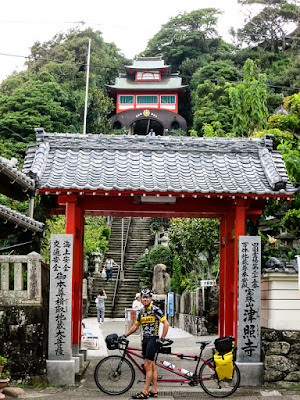
We loved seeing a shrine right on the water. Pete was able to take a panorama shot to capture its setting.

It’s great to ride on bike paths that put us safely away from motorized vehicles. But they do require frequent stops to maneuver the tandem through tight spaces.

We had ridden more than a century when we stopped for cone treats: strawberry ice cream and yuzu, Japanese lemon, sorbet.

This barn door was opened while Kristina was taking this photo. Luckily photography is so common here that the woman didn’t even blink.

As we rode into Kochi, we noticed the manhole cover had a rooster with an incredibly long tail.

Intrigued, we learned it’s a Japanese onagadori that was bred in Kochi from common domestic chickens and green jungle fowl (of the pheasant family). The rooster tails can grow to be over eight meters long!

Day 30, Kochi to Uchiko, 131 kilometers with 2,140 meters of climbing
It was a challenging ride right from the start, in part because of the unexpected rain.

The rain made it hard to see and our route had lots of turns. After less than 10 kilometers we stopped at a Lawson's for a coffee break and to get out of the rain. We have really come to appreciate the convenience stores in Japan!

We wore our rain jackets and shower caps over our helmets for most of the day.


The mist on the hills and the deep green of the forests was beautiful.



Finally it stopped raining and we could see some blue sky.

The sun was getting low in the sky by the time we rolled into Uchiko and found our ryokan, traditional Japanese inn.

Day 31, Uchiko to Beppu, 42 kilometers with 670 meters of climbing
The next morning we walked around Uchiko to explore the old quarter at daybreak.

Uchiko flourished between 1867 and 1912 as a manufacturing center for paper and traditional wax (made from a type of locally grown nuts). The white and yellow walled buildings were merchants’ homes and warehouses.


The historic street is about 600 meters long.

The buildings were filled with many charming details.

90 of these historic homes are still lived in.

We learned that the campaign to preserve this area has been ongoing since 1975, and that it was designated as an “Important Traditional Construction Preservation Area” in 1982.

There were fresh fruits and other things for sale on the honor system. A colorful ear of corn was 200 yen, about $2.

This metal building was unique and we liked the rust patterns on the siding.

This is the Hon-Haga residence. They were very successful in making white wax.

We liked the white crane on the eaves of the building.

We saw lots of school children heading to school. Each wore a school uniform and carried a yellow umbrella, thermos and backpack.

We walked up to Kosho-ji temple. Kristina is in front of the main gate.

Here’s a panorama to show the temple grounds.

You can see the reflection of the temple's main hall in this window.

The early morning light made everything look amazing, such as these buckets and water dippers.

After we'd seen the area, we went back to our ryokan for breakfast. Their indoor hearth is no longer used for cooking, but it's still hung with the traditional chain for holding a kettle.

We were hungry, and we happily ate the best breakfast of our tour. Mostly vegetarian fare included (clockwise from lower left): steamed root vegetables (sweet potatoes, kabocha and chestnut), pickles, fern and something salad, kabocha salad with cucumber, eggplant with miso, sautéed shishito peppers, and bitter melon with scrambled egg. We loved all the variety!

Our host was kind enough to leave the pot of coffee with us after he poured cups for us. We also had rice, fried eggs and yogurt with fruit. Goach samma deshta, it was a feast! It's a good thing we need a lot of calories for all the cycling.

They didn't speak much English, so we were only able to tell our hosts basic information about our cycling tour. They were very curious about our tandem, and very enthusiastic about taking a photo with it.

These baskets of greens will be taken to shrines and grave sites, as offerings.

We rode past this family burial plot that was adjacent to their agricultural fields and house. It is a nice tradition to keep their Japanese ancestors close by and well-taken care of.

The manhole cover with cormorants told us we were getting close to the ocean again.

We took the ferry to Kyushu Island. We were the first to load with our bike, and it was secured to wall of the ferry. Then the cars and trucks were loaded.

The ferry was the nicest so far and even included free Wifi. Kristina used it to get our week 4 blog published since our ryokan in Uchiko didn’t have Wifi.

Day 32, Rest day in Beppu
One of the most common tourist activities in Beppu is to visit "the eight hells", geothermal features such as boiling mud pots and steam vents. Shiraike Jigoku, white pool hell, had frothing white steam in a white water pool.

We spotted another Fudo Myoo, wisdom king, who is holding a sword and a rope and scowling fiercely.

Umi Jigoku, sea hell, had beautiful turquoise blue water and lots of steam. The water is about 90 degrees Celsius when it comes to the surface. Second only to Yellowstone in volume of hot springs water, Beppu has been popular since the 1920s. We were able to enjoy bathing in hot springs water that had been cooled at the onsen where we stayed.

Umi Jigoku also had nice gardens with brightly painted Tori gates.

We carried an umbrella, but luckily we didn't need it.

Nearby was Bozu Jigoku, monk hell, where burps of volcanic mud form rings that look something like the shaved heads of monks.

Warning: cutesy photos up next. Kristina is imitating the tenuki sculpture's head tilt.

We've been to Yellowstone so seeing how touristic Beppu was made us grateful that the National Park Service protects US parks and their natural beauty from cheesy, touristic displays.

Like we saw at Noboribetsu on Hokkaido, the demon-theme is popular at Japanese hot springs.

We're not sure, but we think this is another cutesy tenuki, Japanese racoon-dog.

Happy 50th birthday, Pete! His Neapolitan birthday treats included strawberry and chocolate gelato cones plus a Cremia vanilla softo that was 25% milk fat, our creamiest softo yet!

Day 33, Beppu to Aso, 94 kilometers with 2,195 meters of climbing
Today we rode up a lot of hills. We had 2 hors catégorie (HC) climbs, the hardest level of climbing in the Tour de France. The first was 20 kilometers with an average grade of 3% with consistent ramps to 10% and one up to 20%! The hills did provide great views when we reached the top.

This stone lantern had ferns growing on its cap and a curved rock base. We spotted it as we were descending. The descent was so steep that we broke a spoke on the front wheel, which is very unusual.

We took a break in the art town of Yufuin, which was bustling with shoppers and interesting sights.

Pete is enjoying a coffee gelato cone.

This area of Kyushu raises a lot of cows for meat and milk, hence their manhole cover includes a cow.

We never get tired of seeing rice fields and pretty valleys in Japan.


The second HC climb was 28 kilometers and maxed at 13%. Hossho Peak is behind us, partially covered by clouds.

The highest point on today's ride was 1,330 meters at Makinoto Pass.

It rained for the last 30 kilometers. This road became a lake, forcing us to walk the bike.
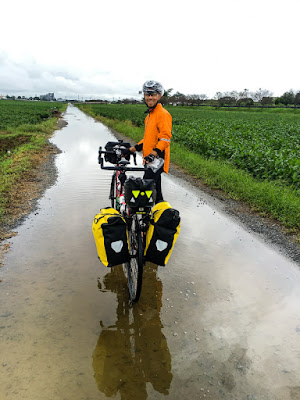
We really need showers after today's ride! Pete is checking out the pillows offered by the hotel.

Day 34 Aso to Yatsushiro, 91 kilometers with 702 meters of climbing
We liked the communal table at our hotel, that included a tree ring section.

We had been to a supermarket the day before where we picked up some tasty prepared food, as we like to have a big, healthy breakfast before we ride.

Mt Aso erupted in 2015 and the volcano remains too active to get close, so we settled for looking at photos of it and buying a postcard that showed the crater.

We started riding in a steady rain that would continue for most of the day. The rain was caused the remnants of Typhoon Megi. Pete is modeling his rain jacket and shower cap in front of the Otohime Shrine.

We saw swollen rivers and washed out roads, the after-affects of Typhoon Megi.

We were riding with the clouds today. Luckily when it rains in Japan the temperature is not cold, about 22 degrees Celsius.

Day 35, Rest day in Yatsushiro
We had planned more rest days for the end of the tour, knowing that riding fatigue would catch up to us. Yatsushiro is where we took our last rest day, and can you guess what we did? We had to get our broken spoke repaired. We feel fortunate that we met Hanazono-san because he found us a nearby bike shop. Hanazono-san had lived in Seattle and played baseball there. He was really friendly and his English was excellent.

Banpeiyu is the largest citrus fruit in the world, and it was first grown in Japan in Yatsushiro. We liked the painted version of the manhole cover. If you have a minute, check out the awesome photos in this banpeiyu blog.

Day 36, Yatsushiro to Izumi, 75 kilometers with 1,100 meters of climbing
We've been eating Nashi pears while in Japan. They are large, golden orbs with really juicy flesh that tastes like the combination of an apple and a pear. You may know them as Asian Pears.

This morning we didn't get any fruit with the hotel breakfast, so we cut a Nashi pear and ate it before we started riding.

It was sunny and clear, for the first time in a week. We took the shortest, flattest route in the hope of having an "easy" day on the bike. And it was, relatively speaking, an easy day, aside from the heat and humidity. It also was a pretty route along the coast with plenty of great views.

Boy was it hot! Plus the humidity was about 85% and we were dripping with sweat.

This photo of Kristina was on a dedicated pedestrian and cycling bridge over the Kuma River. Flying overhead was a great blue heron.

We saw lots of birds as we rode: ospreys, egrets and herons. There was a great blue heron on the bow of this boat.

We startled the great egrets as we rode by, and they took off flying.

We enjoyed riding along the coast of the Yatsushiro Sea.

The views of the sea were stunning as we climbed through the hills. We could see the established aquaculture but weren't sure what was being cultivated.

Climbing hills in Japan is really tiring on hot days, so we took frequent rest breaks. Our breaks made for good photo opportunities.

Kristina has been using Jane Iredale's Lip Drink lip balm with SPF on this tour, and hasn't had any chapped or burned lips, even after 10 hours of riding in the sun. It's by far the best SPF lip balm she's ever used, with no chemical SPF taste. And Pete likes it too.

As we rolled into Izumi we saw their manhole cover and thought it had herons. But we learned that Izumi gets about 10,000 hooded cranes during the winter.

Day 37, Izumi to Kirishima, 80 kilometers with 1,025 meters of climbing
In 2013 we had a blast riding for a week on Kyushu with our friend Ken. The three of us had toured the Izumi Samurai houses, so this time we only took a brief look as we rode out of town.

Izumi's manhole cover design features a Samarai archer.

Here's a look at the inside a Samurai house, in the room where cooking over an indoor hearth was done.

There were many beautiful stone walls and interesting fences in the historic area.

After riding about 20 kilometers we took a coffee break. The Tully's Barrista Black coffee is excellent, and we enjoyed it with a pecan tartlett that we had bought in Izumi.
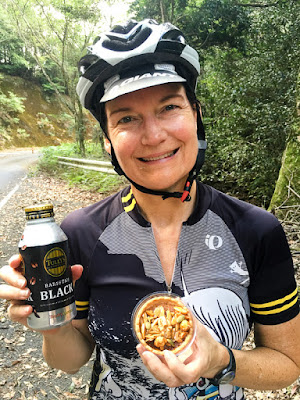
The mountains in Kyushu are very impressive and it's fun to ride in volcano country. There were clouds that helped to keep the temperature cooler than yesterday, which made riding a lot more pleasant.
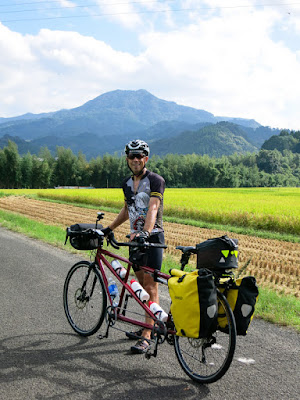
But it was still hot and humid, so we were happy to find matcha softos.

These are the Sogi-no-Taki waterfalls in Kagoshima prefecture.

It looked like a person was using a weed whacker to clean up around the rice field. But it's actually a sculpture complete with sun glasses. We saw several different 'workers' like this one.

Here a family is working to hang up harvested rice to dry.

As you can see, they've been working for quite a while to get it all hung up.

We were getting pretty tired by this point in the ride, but we were still having fun.

Day 38, Kirishima to Ibusuki, 85 kilometers with 850 meters of climbing
After riding about 20 Kms we reached Kagoshima Bay where we could see Mt. Sakurajima, another active volcano.

We knew that Typhoon Chaba was predicted to arrive the next day. As we rode we saw lots of typhoon preparations, such as trucks carrying sand, people making sand bags, and here a crane was lifting huge sand bags into a river bed.
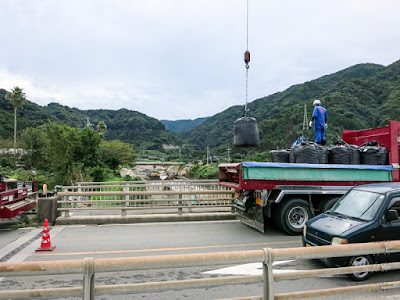
We enjoyed our last softos of the tour, just before it started raining again.

Special thanks to our Bike Angel Claire. We've enjoyed being in touch every day we rode. Here's a photo of Claire riding in Perth - she was inspired to have frozen yogurt after seeing all our softos!

We've had our Keene cycling shoes since 2013 and used them for all the riding we've done in Asia. But we think this will be their last ride - it's time to buy new ones that don't smell and have firm soles.

We did it, we rode the length of Japan on our tandem bike!

We rode 3,025 kilometers with 34,582 meters of climbing over 38 days, 32 days on the bike and 6 rest days. Our daily average was 94 kilometers with 1,072 meters of climbing. Here's a map that shows our route.
Next we take a break from riding and travel to South Korea.